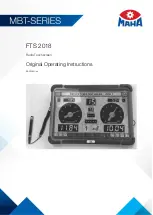
18
5.0 INSPECTION
;
After equipment has been removed from service, it may not be returned to service until a Competent Person confirms in
writing that it is acceptable to do so.
5.1 INSPECTION FREQUENCY:
The product shall be inspected before each use by a user and, additionally, by a Competent
Person other than the user at intervals of no longer than one year. A higher frequency of equipment use and harsher
conditions may require increasing the frequency of Competent Person inspections. The frequency of these inspections
should be determined by the Competent Person per the specific conditions of the worksite.
5.2 INSPECTION PROCEDURES:
Inspect this product per the procedures listed in the “Inspection and Maintenance Log”.
Documentation of each inspection should be maintained by the owner of this equipment. An inspection and maintenance
log should be placed near the product or be otherwise easily accessible to users. It is recommended that the product is
marked with the date of next or last inspection.
5.3 DEFECTS:
If the product cannot be returned to service because of an existing defect or unsafe condition, or because the
product has been exposed to fall arrest or impact force, then the product must be destroyed.
5.4
PRODUCT LIFE:
The functional life of the product is determined by work conditions and maintenance. As long as the
product passes inspection criteria, it may remain in service.
6.0 MAINTENANCE, STORAGE, AND REPAIR
;
Equipment that is in need of maintenance or scheduled for maintenance should be tagged “DO NOT USE”. These
equipment tags should not be removed until maintenance is performed.
6.1 CLEANING:
Periodically clean the lifeline and the exterior of the product with water and a mild soap solution. Rinse the
product thoroughly and air dry. Clean labels as necessary. For more information, please refer to the technical bulletin on
our website:
https://www.3M.com/FallProtection/Mechanical-Device-Cleaning
6.2 DISPOSAL:
Cut or otherwise disable the lifeline, then dispose of the product appropriately.
6.3 REPAIR:
This product is not repairable. Do not attempt to repair this product.
6.4
STORAGE AND TRANSPORT:
Store and transport the product in a cool, dry, clean environment out of direct sunlight.
Avoid areas where chemical vapors may exist. Thoroughly inspect components after extended storage.







































